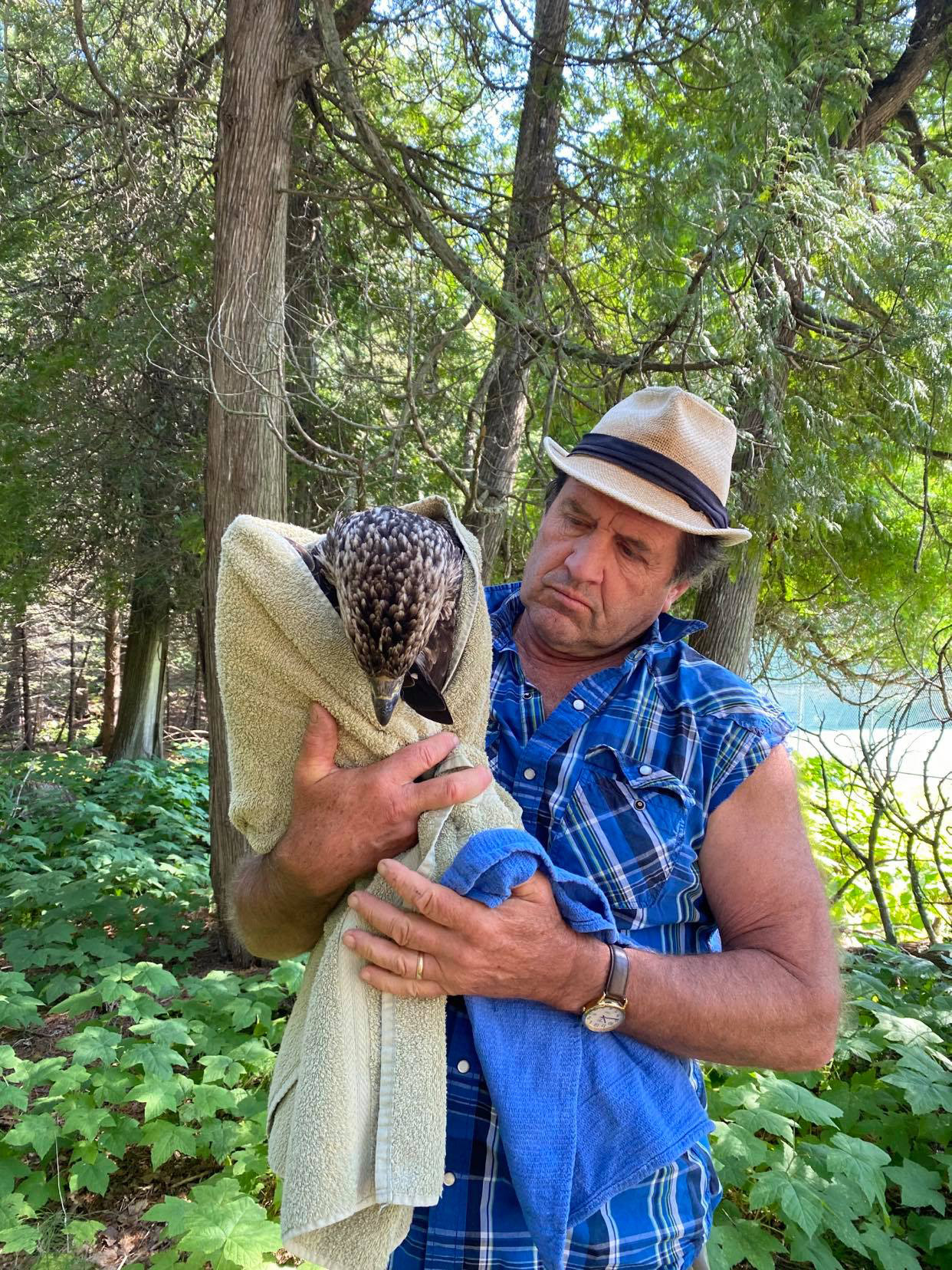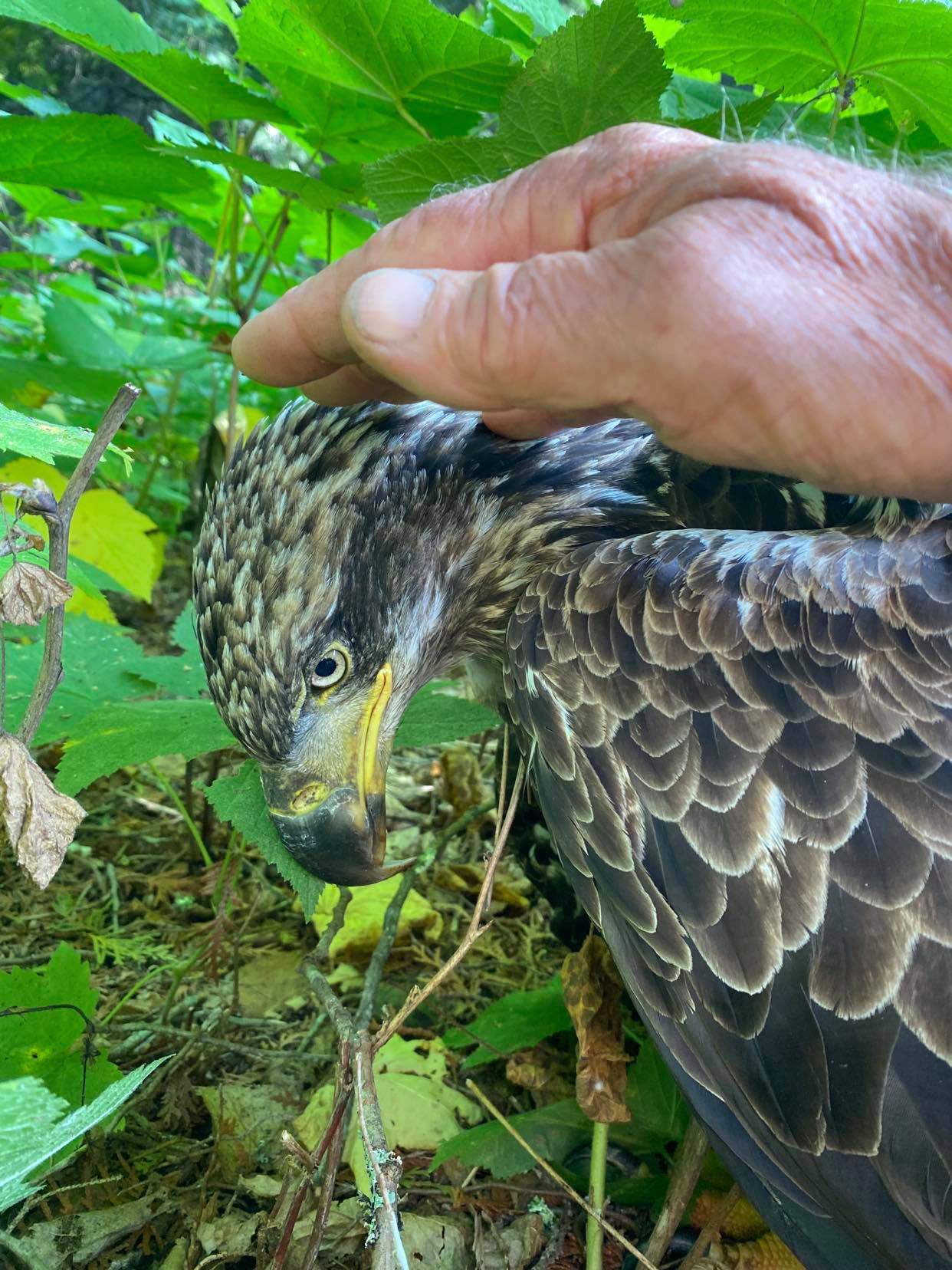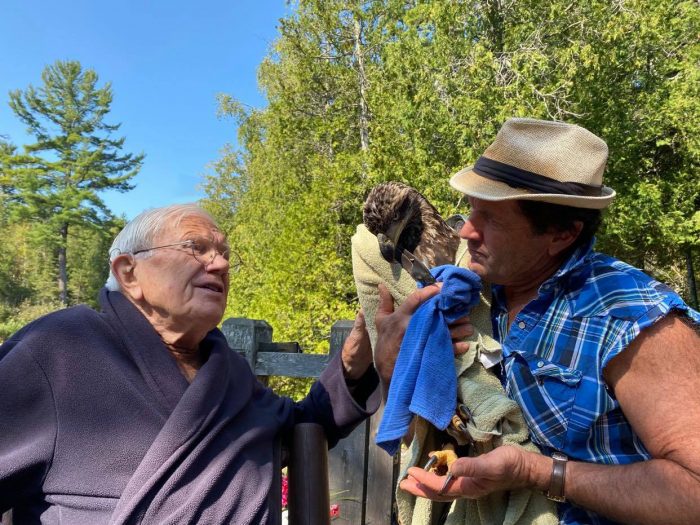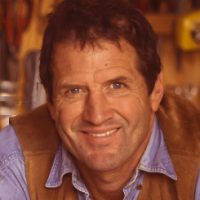I got a bald eagle for my birthday!
It’s true. On my 68th birthday, through the oddest of coincidences, I found, held, cared for, and released a bald eagle.
But the giant, female, broken-winged raptor wasn’t my actual gift.
The gift was a response to an existential question regarding our mortality that had been forming in my mind for some time. Most amazing was the speed with which the gift was delivered, the clarity of the message, and the unusual messenger, a bald eagle.
I’ll do my best to reconstruct the extraordinary coincidental circumstances and convey what I felt was the real gift in this post.
The first thing is to describe the setting. I was on the famous North Shore of Lake Superior. The North Shore is famous because it’s a region where diverse, untamed elements of nature confront each other.
In fact, I write this post from the North Shore. Here, weathered volcanic rock outcroppings covered with orange and green lichen jut into the vast blue waters of the world’s second-largest body of freshwater. Growing atop the rock are vast pine forests that seem to be only barely interrupted by the intrusion of man. Flowing through those forests, tumbling through chasms in the rock, and cascading over cliffs are the white waters of numerous streams and rivers.
I had arrived on the North Shore with my family the day before finding the eagle. The gathering had been suggested by my 93-year-old dad the previous year. Then, as now, he had gathered our family at a log cabin built on an outcropping over a river. The cabin had been built by his grandfather 99 years ago and handed down over the generations.
In addition to my dad—who came in spite of suffering from excruciating neck pain—the gathered included my sister from Evergreen, Colorado, her boyfriend and son, and my very independent 26-year-old daughter from Boulder, who had just returned from making a film in Guatemala.
I was the first one to awaken the first morning at our ancestral family cabin. I didn’t want to disturb the others who were sleeping, so I decided to walk down a footpath a couple hundred yards to the river’s mouth where there was a lagoon and a grassy clearing. The path wound its way amongst moss-covered boulders through old cedars and young birches growing beside the drought-starved rocky riverbed.
It being my birthday, and arriving in the company of family decades older and younger than I, certain existential questions drifted through my mind like the puffy white clouds in the azure sky visible through the towering pines overhead.
I recall hearing different versions of one specific existential question, amplified by the sudden and rapid decline of my dad’s capacities. Don’t we get some sign of our spiritual progress before we die? Do our bodies just give out one day and then we’re dead? Don’t we get a pat on the back and some guidance about which road to choose in the yellow wood?
When I saw the clearing ahead I remembered I had brought bows and arrows so that my daughter, Alondra, and my nephew, Rob, could practice archery with me the way we had done a year ago.
I recalled the massive rotten white pine stump at which we had launched our arrows. The stump had made a perfect target. Its spongy wood absorbed the impact of the arrows and the soft soil of the hill behind it enabled us to find the fletches that missed their mark.
To get to the stump I had to cut through a thicket of thimbleberries that had grown up at the edge of the clearing. I turned and there, directly in my path, stood a gigantic bird, which I had learned to identify only a few years ago as a juvenile bald eagle.
Bald eagles, I’d learned, don’t get the characteristic white plumage on their heads and tails until they are five years old. Prior to that time their heads and tails are mottled tan and brown.
This magnificent bird stood stock-still, head higher than my knee, only eight or ten feet in front of me.
Truth is, I think we both surprised each other because we both stood stock-still. My first thought upon encountering the giant raptor was that I must have surprised it while it was eating an animal it had caught and didn’t want to give up. I thought maybe I had gotten so close that the bird recognized it would be impossible to fly away through the thick, overhanging cedar branches. We stared at each other without moving.
If the fight, flight, or freeze responses to fear were the same for this eagle and me, we both chose to freeze.
I carefully examined the ground beside the bird’s enormous gold feet, which were nearly as big as my own hands. But I didn’t see the remains of an animal anywhere. I began to suspect something else. Maybe this bird was injured or had been poisoned? I decided the best thing would be to ask the bird if it was okay.
“Are you injured?” I asked in a soft but audible voice. Silence. Then I thought, maybe it doesn’t know the word “injured.” So I rephrased the question. “Are you hurt? Is there a reason you’re not flying away?”
The eagle blinked the one eye I could see. I flashed on Julian Schnabel’s movie “The Diving Bell and the Butterfly.” In that remarkable film, the main character, who has suffered a catastrophic scuba diving accident that has left him almost completely paralyzed, can only communicate by blinking his eyes.
For a second, I thought I could tell the eagle to blink once if the answer is yes and blink twice…no, that’s stupid. I wondered if it would let me get closer. So I said out loud, “I’m going to come a little closer, okay?”
I took a couple steps. I realized how much taller I was and thought that my height might be frightening, so I told the eagle, I was going to get down on my hands and knees.
I was now about two feet away.
I noticed that the eagle’s mottled white tail feathers were trembling. “You don’t need to be afraid of me,” I said, “I’m not going to hurt you.”
I decided to show the bird each of my hands, first one, then the other, and then both. I held them in front of the eagle’s eye so it could examine them. Meanwhile, I examined his features. Its beak was huge, larger than my thumb, forming almost a complete semicircle ending in a sharp point. I noticed its nostrils or nares were located in its beak.
I also studied the bird’s talons. They looked like miniature bear claws only much sharper. For years, I’ve made necklaces out of small objects that I’ve found. Those talons would make a cool neckless, I thought. Then I wondered if the eagle and I were communicating telepathically. Just kidding!
I continued scanning. I noticed the tail feathers were no longer quivering. Humm, he’s not as afraid. “I’m going to rub your back,” I said, confident that the bird had accepted my close proximity. I moved my hand slowly and gently let my fingers touch the feathers between its shoulders.
The eagle adjusted its footing. It was the first time it had moved. When it did so, I could see that its right wing didn’t hang in quite the same way as the closer left wing. I gently stroked the eagle’s shoulders repeatedly. Then it took a step forward and buried its head beneath the large soft leaves of the thimbleberries. It blinked its eyes slowly. Much slower than before.
“Oh no,” I thought, “this might be it.” I watched for signs of persistent or vanquishing life for a couple more minutes. “Or maybe it’s just relaxing,” I assured myself. The ephemera of the moment struck me. I felt an urge to share it with my daughter. I wanted to go get her.
As if to assure me it wasn’t going anywhere, the eagle lay down. To see a bald eagle so exhausted felt tragic. The uncharacteristic behavior confused me. I felt a tremor in my abdomen. My chest constricted. I gasped for breath—like I was drowning.
I could see the eagle’s body rise and fall as it breathed. It blinked even slower than before. I gently stroked the back of its head and neck the way I had stroked my children’s heads when they were falling asleep. The eagle lowered its beak and closed its eyes.
I ran as fast as I could to the cabin. I saw Alondra’s window was open and began shouting, “Alondra, Alondra, Alondra, wake up!” before I got to the front door. She greeted me in the entry.
“What, Dad? What is it?” she cried, sensing my urgency but still groggy.
“Alondra, come right now. I’ve been patting a bald eagle,” I gasped, breathless from sprinting 200 yards up the river bank.
She followed me barefoot back down the river at a full run. When the clearing appeared, we stopped running and feigned nonchalance. The eagle was on her feet again. She seemed to recognize me. I knelt beside her and resumed patting her, especially behind her head.
Alondra and I talked about what a high level of trauma the bird must have suffered to allow it to accept the touch of every animal’s archenemy—a human being. Alondra took some pics, looked up a raptor center in Duluth, and called it. “They’ll have a volunteer here in an hour,” she said.
Alondra and I stared at each other without saying anything for a long time, the way the eagle and I had done.
“What are you feeling, Dad?” she asked.
When I checked in with myself, time stopped. I felt overcome by a deep sense of nostalgia, a yearning for something lost long ago. My eyes began to water and my chin began to quiver, like the tail feathers of the eagle. I jammed my tongue against the gums of my lower teeth and gasped for breath. I couldn’t seem to get enough air. I was afraid the bird was dying right in front of me. I felt helpless to save it.
Without saying a word, Alondra placed her hand on the back of my neck and rubbed her hand from one shoulder to the other. She consoled me the way she had just seen me console the eagle.
“Alondra, do you see how this creature is a metaphor? This bird is Dad.” My throat tightened, and my eyes swelled with tears.
“Look how tired it is,” I continued. “And all I can do is pat its neck, just like I do for Dad. Is that all we can do for one another? Is that all I can do for Dad? Pat his back as he bows down ever closer to the earth?”
The eagle blinked its eyes slowly. It was too tired to continue doing even what it is most known for doing—seeing!
I stared at Alondra through my own tired eyes.
“I think all we can offer one another, in the end, is love,” Alondra said. She paused, “I think love is beautiful enough.”
“I can see the eagle really does like your pets,” she continued, reassuring me with great kindness, “The way it’s bowing down its head when you rub it.”
I nodded. Then I turned and knelt beside the fallen eagle. I gently wrapped it in a towel, lifted it into my arms, and carried it back to the cabin. The raptor volunteer was waiting with her soft cage in the back of her SUV. She said she believed the eagle was a female because of its large size.
“I want to show the eagle to Dad,” I said barely slowing as I passed her. I found Dad on the deck in his pajamas and robe.
“My god, what’s that?” he exclaimed,
“Its a bald eagle,” I replied. Dad’s eyes were fixed on the mighty bird’s head. Dad’s mouth was agape.
“What?! A bald eagle! Where did you find it?”
I gave him a brief synopsis of the story. “There are 330 million people in this country. Do you know how many of them have befriended a wild bald eagle?”
“Not only that,” I replied, “Do you remember what day it is?”
“Oh my god,” he exclaimed, “Happy Birthday! You got a bald eagle for your birthday!”
Yes, I got a bald eagle for my birthday, but that wasn’t the gift. The gift came from sharing the moment with the people I most love. It wasn’t a show with a final curtain drop followed by a cast party.
The gift I received is an ongoing process of being present for those beings around me. We get the gift when we give our love. It’s an endless self-perpetuating convection whether carried out with our family and friends, complete strangers, or a bald eagle.
~
Author’s update:
The volunteer who picked up the eagle had given me a contribution form upon which she wrote a case number. She told me I could contact the organization to learn what happened to the eagle. Day after I got home, I sent an email in which I mentioned the date and circumstances, indicated the case number, and requested an update.
The volunteer had warned me that if the eagle’s wing bone was broken it could be repaired but if a joint was torn, it would be euthanized. I was sure it was broken and would heal.
I pictured it recognizing me, on a future visit to the North Shore, from its perch atop one of the giant old white pines. I’d sell the rights to the story of our relationship to Disney. It was an adolescent vision with my friend, the mature bald eagle, circling overhead and a rosy sunset in the background.
A couple days had passed before I spoke to a woman at the rescue center. She had no recollection of what had happened. She asked for the case number. There was a long silence while she looked it up.
“Sorry,” she said, “We get so many eagles here. That one died within an hour of arriving.” She explained that the animals that come to them are traumatized so they put them in isolation for a period of time to calm them. The “eagle in question” was dead when she went to retrieve it.
I thought of that majestic bird dying in a small box in a storeroom. I quickly ended the call. I felt crushed. Literally. My chest constricted. I bit my lip. I stared blankly out the window.
Had I done the right thing? What if I’d held it in my arms? What about my dad? What was I going to do when his energy waned beyond the point where he could care for himself? Was I going to put him in a box—in a home somewhere where he’d die alone in a space he didn’t recognize?
I had wanted to be a hero. I’d wanted to save the bald eagle. Instead, I’d caused it the ultimate indignity. I felt so disappointed.
The only thing I was sure of was that for a brief period, I had calmed the eagle’s fears with patience and kindness, and gentle touch—the essence of love.
~
Two more photos from that day




 Share on bsky
Share on bsky





Read 3 comments and reply